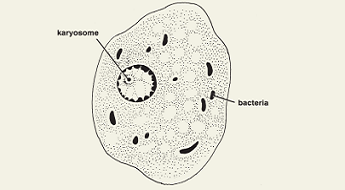Genus Entamoeba includes a group of amoebic parasites. Among them Entamoeba histolytica is an important human pathogen causing amoebic dysentery as well as hepatic amoebiasis. Entamoeba coli is a commensal of large intestine, but doesn’t invade tissues.
Definitive diagnosis of amoebiasis depends on the demonstration of E. histolytica trophozoite or cyst in stool. Cases might get misdiagnosed because of similarities in their structure. Following are the structural differences between E. histolytica and E. coli.
Definitive diagnosis of amoebiasis depends on the demonstration of E. histolytica trophozoite or cyst in stool. Cases might get misdiagnosed because of similarities in their structure. Following are the structural differences between E. histolytica and E. coli.
| S.N | Characteristics | Entamoeba histolytica | Entamoeba coli |
|---|---|---|---|
Trophozoite |
|||
| 1. | Structure |  |
 |
| 2. | Size | 12-30 µm | 20-40 µm |
| 3. | Motility | Progressive.
Hyaline, fingerlike pseudopodia |
Sluggish, nondirectional
Granular pseudopodia |
| 4. | Nucleus | 1, difficult to visualize in unstained smear | 1, often visible in unstained smear |
| 5. | Karyosome | Sharp central | Eccenteric |
| 6. | Pheripheral Chromatin | Fine and dispersed | Coarse and Clumped |
| 7. | Cytoplasmic Inclusions | RBCs, leukocytes and tissue debris but no bacteria | Bacteria and other material but never RBCs |
Cysts |
|||
| 1. | Structure |  |
 |
| 2. | Size | 10-15 µm | 15-25 µm |
| 3. | Shape | Usually spherical | Usually spherical, may be oval, triangular or other shaped |
| 4. | Nucleus | Mature Cyst=4 nuclei | Mature Cyst=8 Nuclei |
| 5. | Peripheral Chromatin | Fine and dispersed | Coarsely granular or clumped |
| 6. | Chromatoid Bodies | Rounded ends | Filamentous, thread like, pointed ends |
| 7. | Glycogen Mass | Visible in uninucleate stage | Large and visible in binucleate stage |

Very nice drawings. One question. I think I learned that the number of nuclei for E. histolytica cysts was four or less and for E. coli it was more than four. I know for cysts in transition there maybe some exceptions, but for mature cysts am I wrong?
Hello Tod,
The early cyst contains single nucleus. In case of E. histolytica, as the cyst matures, the nucleus undergoes two successive mitotic divisions to form two and then four nuclei. The mature cyst is quadrinucleate. Hence number of nucleus varies from one to four. It varies from one to eight in case of E. coli, and mature cyst contains eight.
Comeback garnu vayexa.. khusi laagyo sir
Thank you sir 🙂
When we found nuclei 1-4. How can differentiate that is E. Coli or E. His. If nucli is not clear to see karyosome.
Nucleus is not only the feature to differentiate. Please refer to table above.